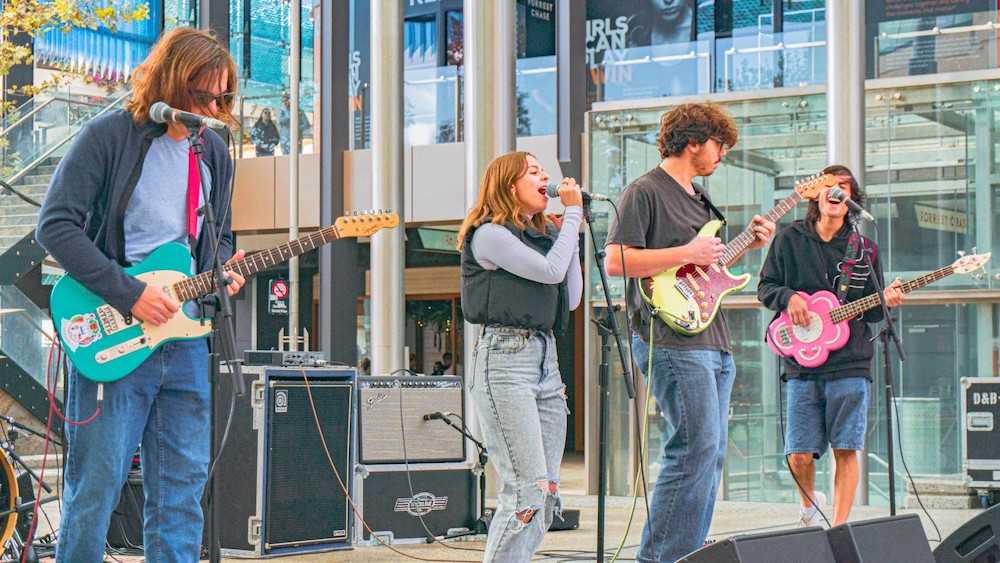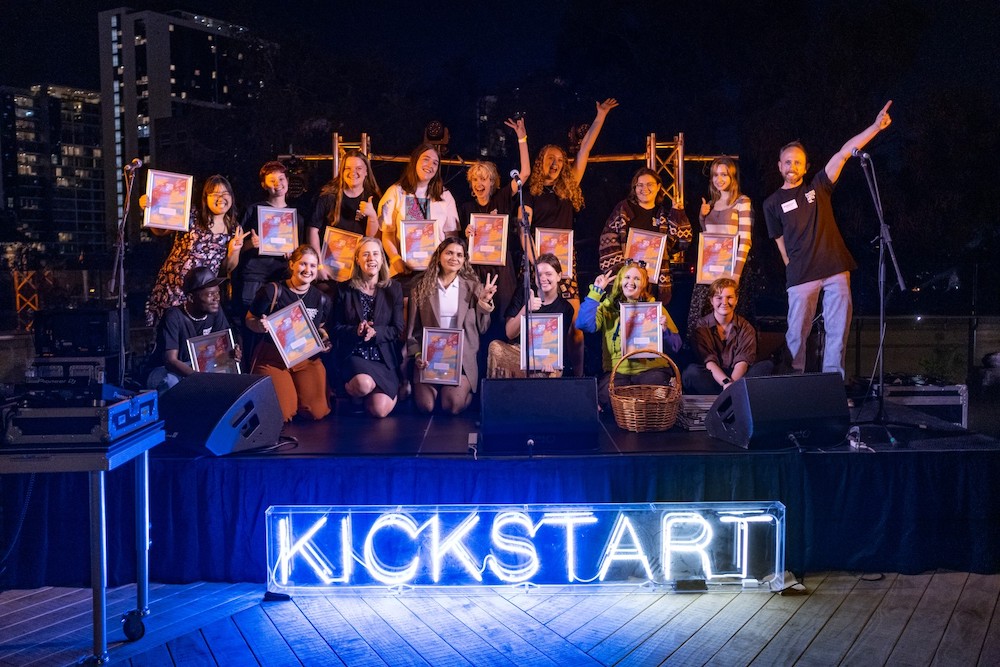With peak bodies hit hard in the State Government’s latest funding round, Victoria Laurie looks at the cost for the arts and some of its biggest advocates.
Arts funding lost in translation
31 May 2023
- Reading time • 10 minutesMulti-arts
More like this
- Halloween special: How to make blood and other stage tricks
- Seadragon weaves magic spell
- Spring into the school holidays
Artistic director of Barking Gecko Theatre Company Luke Kerridge recently made a wistful comment to an audience of young theatre performers. “I spend most of my time arguing for the existence of children’s theatre.” He said he wished he didn’t have to.
It was a succinct argument for advocacy, and for service organisations that support and promote the work of artists like Kerridge, whose actual job is to produce inspiring theatre for young audiences.
Few people would deny that the creative industries are in need of greater advocacy. It was glaringly obvious at the height of the COVID pandemic, when out-of-work artists were disqualified from getting JobKeeper payments. In Kerridge’s sector alone, by the time he finished his drama studies, dedicated theatre companies for children were declining.
In 2007 there were 21 children’s and youth arts companies that were federally funded. Currently, there are only three federally funded theatre companies specialising in work for children in a country of 4.7 million children, and four federally funded youth arts organisations.
Advocacy, or the lack of it, can affect funders and decision-makers, and influence whether a schoolchild gets their first experience of the arts. One arts promoter researching youth audiences discovered that a regional Northwest town had eight schools and hundreds of students, but only a single drama teacher. There were double the number of music teachers – meaning only two.
“What if every child grew up knowing there’s arts at every level of schooling?”, asked Kerridge, looking around at a room full of aspiring performers, technicians, designers and choreographers in their teens and twenties.
Arts advocacy under threat
This raises a question about the decline in advocacy that may result from the latest funding round of WA’s Department of Local Government, Sport and Cultural Industries’ (DLGSC) Arts Organisations Investment Program, or AOIP. Increased from three years of funding to four, the round covers 2024 to 2027. Most of the companies that were unsuccessful in regaining funds were service organisations, in full or part.

The AOIP news was good on the surface – 37 West Australian organisations out of 63 applicants will receive a total of $56 million over a four-year period, up from $10.5 million per annum to $14 million per annum for arts bodies.
The AOIP program invites applications from producer/presenter organisations as well as service organisations. But the latter has been conspicuously dropping off the list.
Those who lost AOIP funding in this round include peak bodies Artsource, Propel Youth Arts WA, Writing WA and West Australian Music (WAM). Another, Perth Centre for Photography, is a sector service body that also presents exhibitions. Two defunded groups are producers – Spaced, which specialises in art project exchanges in niche – often regional – locations, and avant-garde art producer PVI Collective, which creates works designed to disrupt power and privilege.
Six new organisations received AOIP funding for the first time, but no peak body or exclusively-service organisation featured on that list.
According to a DLGSC response to Seesaw Magazine’s questions, “not all organisations can be funded and some that were successful in 2019 will not receive funding under this round of AOIP”.
“DLGSC is currently reviewing the needs of the sector and the roles of affected service organisations or peak bodies to inform future funding strategies.”
What do we stand to lose?
What exactly is a peak or service organisation? In 2017, an Australia Council survey broadly defined them as “organisations whose core purpose is to provide programs and activities that support artists and art producers/presenters.”
The Australia Council’s nationwide survey of arts service bodies included 11 West Australian service organisations. Of those listed, five have now been defunded by the state. They are Artsource, Propel Youth Arts WA, WAM, Writing WA and Ausdance WA, the sector body credited with nurturing collegiality among various dance companies before it lost AOIP funding in 2018.
Ausdance WA presented the biennial MoveMe Festival, which strove to put a spotlight on WA-based talent in the contemporary dance sector. It ran the Festival until 2019 when its funds ran out. Ausdance WA now exists only as volunteer-run organisation.
The New South Wales State Government seems to value its arts service organisations. A 2021 NSW Arts and Cultural Sector Service Needs Review concluded that they “provide highly valued benefits to the arts and cultural sector, audiences and Create NSW.” It found sector organisations “are essential to the NSW Government’s aims to support the sector to thrive and to increase participation in arts and culture across our diverse community.”
It even recommended that $300,000 per annum be set aside for “a strategic fund…to address gaps between sector demand and supply of key services.”
So if a peak or service body disappears in WA, who cares?
Some might argue that current success is founded on more than two decades of WAM advocacy and talent development in city and regions.
“As a peak body for West Australian music, it’s obviously disappointing,” says president Al Taylor about WAM’s failure to secure future AOIP funding. The news came as a surprise, he adds, because WAM had been working closely with DLGSC on a strategy (also department funded) to boost its activities, with proposals like a virtual WA Music Hub and mentoring program.
It could be argued that WA’s contemporary music scene is thriving without advocacy – a survey (albeit eight years ago) identified more than 350 live events a week, 400 venues, 2900 jobs and a nearly billion-dollar industry. Today, WA bands like Tame Impala are headlined at the biggest festivals in the world, while Fremantle-based Voyager has just been a finalist in this year’s Eurovision song contest.
Whether WAM’s uncertain fate, and possible closure, will damage the music industry is pure speculation. Some might argue that current success is founded on more than two decades of WAM advocacy and talent development in city and regions. Taylor says he remains optimistic – he’s working with the department on “an alternative way of funding and restructuring WAM”.
The Department says that unsuccessful applicants have been given 12 months’ “fair notice” and extended contracts until 28 April 2024. After that, there are “other funding opportunities … and we encourage all organisations to explore all funding avenues available to them.”
A question of transparency
A recurring theme reported to Seesaw Magazine is that companies are no longer sure they even understand what the department wants. Or as Jamie McGleave, general manager of now defunded Propel Youth Arts WA, puts it: “They haven’t figured out the questions they want us to answer, and there doesn’t seem to be a policy for what they expect.”
The Chamber of Arts and Culture’s CEO describes it as a case of policy “lost in translation”.
The Chamber of Arts and Culture WA’s CEO Kim Jameson (who has recently stepped down from the role) describes it as a case of policy “lost in translation”. As for AOIP’s shift away from funding service organisations, “I don’t know what the thinking is that’s triggered this shift.”
“What’s the vision? What are we trying to achieve? Without a clear [arts] policy, the whole thing is opaque and we’re not getting the full picture,” she says. In stark contrast, “the last Federal arts budget was very clear about what was being invested in and why”.
The “lost in translation” message has been echoed, in a more formal sense, by a review of the DLGSC, released in May, as part of the Government’s new Agency Capability Review Program.
The reviewers, which included former Australia Council chair and Arts WA executive Margaret Seares AO, pinpointed the need for “an overarching strategy that articulates the desired outcomes to be achieved through the grants function … This is reiterated by a number of stakeholders who suggest grant activities are not conducted in a consistent or user-centric way or within a guiding strategy”.

Propel’s defunding defies logic in a state with plenty of resource riches and serious problems amongst young people. Last year, Premier Mark McGowan (who just announced he will leave politics at the end of this week) said tackling “youth crime” was a key budget priority.
“There’s so much tragic news out there involving young people,” agrees McGleave, referring to the Banksia Hill juvenile detention riots and almost nightly coverage of disengaged youth clashing with teachers or each other.
Propel’s statistics point to a small arts body in hyperdrive – it currently engages with 800 young people, ages 10 to mid-20s, many of their families and several thousand subscribers.
Only the week before news of its defunding, Propel had held the Youth Week WA KickstART Festival, which had over 7,000 attendees across more than 50 individual events. It was supported by the Department for Communities, Lotterywest, DLGSC (via the CBD Revitalisation Fund), and the City of Perth.
“We were doing everything asked of us, and we were strongly encouraged to be more ambitious.”
Propel partners with the WA Youth Awards, offers a Creative Endeavours Award and provides talented youngsters to perform at the event. In total, 70 Propel events are held each year. The entire work is done by six part-time employees, including McGleave; their combined arts salaries would equate to the salary of a single middle-ranked mining executive.
Propel receives project funding from Healthway, Lotterywest and the City of Perth and Melville to conduct activities with youth. But the Department’s AOIP funding represented a valuable one third of Propel’s operating income; “it covered our overheads to run the business”.
“The hardest part is not to take it personally,” says McGleave. “We were doing everything asked of us, and we were strongly encouraged to be more ambitious.”
A senior policy maker who didn’t want to be named told Seesaw Magazine that the state’s Cultural Infrastructure Project 2030+, released in December 2020, had laid out a clear pathway. “AOIP was in the context of this broader policy. They had a perfectly good plan. Just go back to the plan,” the source told Seesaw.
“There were targets, actions – the aim was to build a creative base and employment base, it was an ‘artists first’ policy. You have to create more artists and building blocks for the growth of the industry. You need service organisations underneath. If you’re a writer now, where do you go after Writing WA? Amazon or one the few publishers with even fewer resources?”
McGleave says funding rejection has only spurred him on to advocate more loudly for young people, the very thing that Propel was set up to do.
“I’m now determined to be a squeakier wheel,” he says. “The government can do much more to engage young people in a positive way, to help them become wonderful citizens.”
Pictured top: A scene from ‘Killjoy’ by Kimberley Parkin, which was presented by Co3 Contemporary Dance earlier this year. Pictured is Luther Wilson. Photo: Chris Symes
Disclaimers:
Seesaw Magazine applied for AOIP funding for 2024-2027 and was unsuccessful.
Seesaw Magazine’s Business and Marketing Manager Gabrielle Sullivan is director of Ausdance WA.
Like what you're reading? Support Seesaw.






